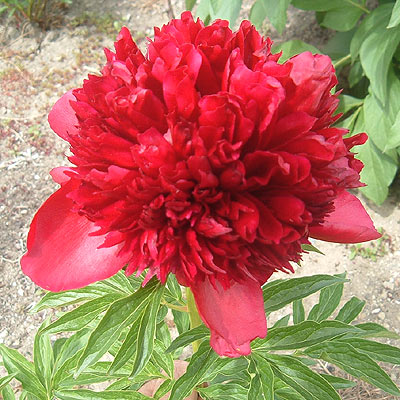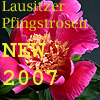origination:
RED CHARM (Glasscock, 1944) - Double - Red - Early - Hybrid. Tall. Seedling No. 12-K 17. Bomb shaped, rich red. Large bloom with tall, stiff stems. Albiflora x Officinalis. Bulletin 103.
RED CHARM Red Charm has been the top winner in the hybrid peony class at all the large shows. A sensational red double. It comes into bloom very early in the season. The flower is large and perfectly formed. The stems are strong and hold the large blooms erect. The substance and texture of this full double, high built bloom is like brilliant plastic. The foliage is excellent.
Kortmann (1998)
'Red Charm' (Glasscock, U.S.A., 1944) (P. lactiflora x P. officinalis) Bloemen donkerrood, zeer groot, gevuld, centrum gevuld met vele dieprode petaldiden, omgeven door twee rijen grote tepalen; bladeren vrij groot, matgroen, bovenzijde iets onregelmatig; hoogte 100 cm; bloemstengels vrij stevig; vertakking matig. Deze Amerikaanse cultuurvariëteit valt op door de prachtige kleur en de enorm grote bloemen, die steun nodig hebben om overeind te blijven, ondanks dat de plant stevige stengels heeft. Door de matige vertakking en de ontwikkeling van zogenaamde nekken aan de wortels vergt de vermeerdering en daardoor de verspreiding op grotere schaal enige tijd. 'Red Charm' schijnt iets gevoelig te zijn voor Botrytis, hetgeen ook de keuringscommissie moest vaststellen. Het is een goede pioen voor de tuin, ondanks enkele negatieve eigenschappen.
M.S. Uspenskaja 2003, p. 112:

Red Charm (Glasscock, 1944) Deep red, bomb-type double, early, 32" tall, hybrid. Gigantic double bomb of deep crimson with a multitude of petals piled high in the center. Slight clove fragrance. APS Gold Medal Winner, 1956. Our most popular peony.
'Red Charm' (Glasscock 1944) : flr. très double en bombe rouge profond, 90cm, tardive.
RED CHARM (Glasscock, 1944) (Lactiflora x Officinalis). Splendide fleur double composée d'une collerette de deux rangées de pétales larges, entourant une masse serrée de pétaloides, de même couleur rouge foncé pur et très vif. Feuillage dense.Tardive pour un hybride. Hauteur moyenne. Parfumée.
RED CHARM (VF)(M) (Glasscock) Gigantic double bomb piled high with a mass of red petals framed with a fan of wide red guard petals; old rose fragrance with a hint of cloves; deep, glossy dark red coloration; a garden favorite and a sell-out every season; APS Gold Medal winner; when ordered for fall
Red Charm Domed, fully double, rich red flowers with a collar of large guard petals. Borne on stiff stems above big glossy leaves. Early.
RED CHARM This full double peony is a real eye catcher, especially to the men! Rich red in colour with the guard petals and large bomb centre all the same shade. This one certainly has Bruce charmedi Red Double, Early, 80cm.
Red Charm Season Type Double Color Red Size 32" Details Sensational deep red hybrid. Each flower exposes itself into a high rounded mound with larger guard petals. Enormous blooms. Abundant bloomer with a mild sweet fragrance. APS Gold Medal winner.

RED CHARM
Flower type: Peony—Bomb
Size: 36"
Plant zone(s): 2-8
Bloom time: Early, Hybrid.
Hybridizer: Lyman Glasscock
Eye catching, deep red double with abundant ruffled petals. This variety is always a favorite of peony growers. A classic. One of the finest reds ever introduced.

Plant Delights Nursery 2005
Paeonia 'Red Charm' (Red Charm Peony)
SunZone: 4-8, possibly colder 36" tall Origin: Hybrid
NEW! Paeonia 'Red Charm' is not only a gold medal winner from the American Peony Society, but it also prospers in the South. This early flowering (early May in NC) hybrid from Lyman Glasscock makes a 3' tall clump of sturdy stems topped with large, fully double bright-red flowers. We are thrilled that this has performed so well in our heat tolerance trials.

RED CHARM, Glasscock (USA), 1954, Hybride - Paeonia officinalis x P. lactiflora, Wereldwijd officieus bekroond tot ‘Koning der Pioenen’. Prachtig donkerrode bomvormig geheel gevulde bloeiwijze. De enorme hoeveelheid binnenste kroonblaadjes omringd door grote ronde bloembladen in combinatie met de diepe rode kleur maakt deze pioen heel bijzonder. Prachtig grof blad waar het officinalis-ouderschap uit spreekt. Ondersteund door zeer dikke stelen vormt deze cultivar een massieve tuinplant die gegarandeerd de bewondering van de buurt zal oogsten. Bekroond met de APS Gold Medal in 1956.
RED CHARM, Glasscock (USA), 1954, Hybrid - Paeonia officinalis x P. lactiflora, The standard to which all peonies are compared to... Widely recognized as the No.1 peony, all over the world. Incredibly intense, pure red colored full double bomb-shaped flowers. The perfectly formed, very large flowers consist of high piled masses of red petals surrounded by wide red guard petals. No sidebuds. Coarse leaflets on extremely stout stems. A 100% traffic stopper, so rightfully awarded with the APS Gold Medal in 1956.


Svetlana Poperechnaya 2006:

Al Rogers
Wilsonville, Or. on Y!groups febr. 2006:
The question arose some time ago about different clones with the same
name.
In 1976 we at Caprice bought (I think 25) R.C. from Gilbert Wild's in
Missouri. Good plants that increased well but before we realized some RC's would
come from adventitious roots - it often two 2-3 years for bufs to show..
In the fall of either 1982 or 1983 we bot the peony collection of Clarence
Blocher of Wheaton, Illinois. These were old clumps, planted between the
sidewalk and the street. (my back's never been the same since.).
There were either one or two of these huge clumps of Red Charm. After several
divisions (they would have been planted with each other) we discovered a
number of plants that were fragrant. I assume these came from Blocher (who got
them from Nate Rudolph). Peony bloom time was open house time at Caprice and we
never had time to tag the fragrant ones.
Since we never niticed fragrance when we only had plants from Wild's I assume
they were the Blocher plants..
In talking with some old time nursery and hybridizers of things like Iris
and Dalhlias- pre 60's I found some had a different idea of what a clone was.
If in a long row from the same cross they found two that appeared the same
they'd consider them "one" and introduce them as such.
This may be what happened with the Red Charm
Al Rogers
Wilsonville, Or.
Todd Miles on Y!groups febr. 2006:
I suppose that there is no way to tell without a genetic scan, and
who would want to pay for that?
In several generations of apple growing, we were always on the
lookout for "limb sports" (one limb on a tree with better apples)
and "bud sports" (a whole tree in a row of the "same" that is
better. Because of this scouting by hundreds of growers there are,
for example, dozens of Red Delicious "sports" in commerce, both
reproduced by nursery companies and home grafted versions. Each of
the various sports, I am told, even though it is a direct decendant
of the "original" Red Delicious has a slightly different genetic
makeup. The genetic makeup is not enough to let them pollinate each
other but they are different none the less.
Peonies, I know from Al's book, can provide 2 very different plants
when a clump is divided, perhaps as a result of a mutation? I had my
own experience this past spring. A Prarie Charm sold to me the fall
before "begged" to be divided. I planted the (now) 2 good sized
roots next to each other. Half the root bloomed as it was supposed
to. The other half bloomed with a rather unattractive, blue
bordered, dirty white flower. Because the plant was young, I didn't
let it set seed (or more than 1 flower). This year, if it still
shows the wierd flower, you can bet I will save the seeds if it sets.
So back to the original subject......If somebody were to do a CSI
type genetic map of my 2 peonies from the same root, I wonder how
different they would be???
Todd Miles
Gerry Parker
Durham, England on Y!groups febr. 2006:
Al
Spot on. There is a very similar view of 'clones' explained in one of
Marjery Fish's books. It related to hellebores.
She died in the sixties I think, and her story related to an 'old'
nurseryman who picked clones out of a row of seedlings.
Gerry Parker
Durham, England
Reiner Jakubowski on Y!groups febr. 2006:
Fragrance in Red Charm has been noted before. At the APS show in
Cleveland OH, in 1951, Harold Stollery noticed "a mild but delicious
fragrance" in the Red Charm on exhibit. There were many Red Charm entries in
that show and Marvin Karrel's entry of it was Grand Champion. Stollery
doesn't say if he tested every one. In the Amateur Division at this show,
in the "Herbaceous Hybrid, Double Red' class, Mary Freeborn won first
and second with 'Ginny' and 'Angelo Cobb Freeborn' respectively. W. S.
Bockstoce placed third with 'Diana Parks'. Kind of makes you wish you
had been there.
In my garden fragrance seems to be variable in some cultivars from one
year to the next, while with others it is a very reliable feature each
and every year. Weather probably has a role to play and certainly how
well they're grown affects many things. What may be unusual in Al's
experience is that some were and some weren't when all conditions should
have been the same. Perhaps there was something that the roots from
Clarence Blocher still had enough of, even after division, that accounts for
the difference observed.
In horticultural nomenclature the concept of "cultivar" is central to
everything else. It is by definition "an assemblage of plants that has
been selected for a particular attribute or combination of attributes
and that is clearly distinct, uniform, and stable in these
characteristics and that when propagated by appropriate means retains those
characteristics."
Where Al uses "clone" the word "cultivar" could be inserted. If
Glasscock had taken more than one seedling and introduced them under one
cultivar name, then we could end up with two Red Charm having slight
dissimilarities which may or may not be noticeable. My feeling is that he
would not have done this and I have never read anything to suggest
otherwise. Saunders however, is known to have done this sort of thing on
several occasions. I think that the big difference between these two men is
that Glasscock was trying to produce new and better cultivars. Saunders
did this too, but in his case they almost seem to have been a
by-product of his trying to increase the gene pool available to hybridising.
Even after his death his daughter Silvia continued to distribute peonies
with particular emphasis on their genealogy. A hybridiser may be less
concerned with using a particular cultivar, than with using a desired
parentage.
Clone has a meaning different from cultivar, though when it comes to
peonies, the cultivar is to be made up of a population of plants each of
which is a clone of the original. Clone simply means a plant (or other
organism) derived from another plant by asexual propagation and which
remains genetically identical to the "parent".
Grex may have a meaning outside of horticultural nomenclature though it
seems to have been much used within it at some time previous. Now, only
orchid nomenclature is allowed to use the term. In orchids a grex is a
type of Group where all members are the result of an artificial cross
from specified parents. As long as it meets the parentage requirements
it is a member of that group regardless of what it looks like.
Reiner Jakubowski









Wilhelm de Wilde 2007









